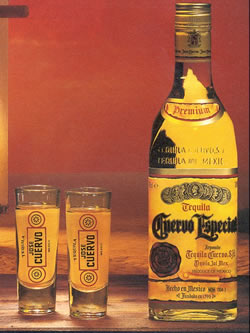Difference between Tequila and Vodka
Key difference: Tequila and vodka are two different alcoholic beverages. Tequila is a distilled spirit that is composed from the blue agave plant. Vodka is a distilled spirit that is composed of water and ethanol.
 Alcoholic drinks serve a variety of purposes today. It is present at almost every event such as a party or a get-together. It can also be served as an ice breaker on a new date or as many people claim it help drown out sorrows and other worries. They have practically become a main part of our culture. There are a variety of different alcoholic beverages that can be consumed including vodka, whiskey, gin, rum, scotch, tequila, etc. However, each drink differs in terms of flavor, appearance, process of making etc. Tequila and vodka are two different alcoholic beverages.
Alcoholic drinks serve a variety of purposes today. It is present at almost every event such as a party or a get-together. It can also be served as an ice breaker on a new date or as many people claim it help drown out sorrows and other worries. They have practically become a main part of our culture. There are a variety of different alcoholic beverages that can be consumed including vodka, whiskey, gin, rum, scotch, tequila, etc. However, each drink differs in terms of flavor, appearance, process of making etc. Tequila and vodka are two different alcoholic beverages.
Tequila is a distilled spirit that is composed from the blue agave plant. The blue agave plant grows primarily around the city of Tequila, Mexico. Hence, most tequila distilleries are located in the surrounding area. According to Mexican Law, tequila can be produced only in the state of Jalisco and limited regions in the states of Guanajuato, Michoacán, Nayarit, and Tamaulipas. However, it can be shipped in large quantities to the United States of America to be bottled, and eventually sold.
Tequila was first produced in the 15th century. It generally has 38–40% alcohol content, which is 76–80 proof. Some types of tequila may be produced with an alcoholic content as low as 31% (62 proof) or as high as 55% (110 proof). However, these are uncommon.
Under Mexican Law, only tequila which is 100% agave can be sold as tequila. Even so, as per American Law, tequila which is 51% agave can be commercially labeled as tequila. These types of tequila are usually called mixtos in Mexico.
According to Wikipedia, there are 5 different types of tequila:
- Blanco (white) or plata (silver): white spirit, un-aged and bottled or stored immediately after distillation, or aged less than two months in stainless steel or neutral oak barrels
- Joven (young) or oro (gold): usually a mixto (rarely 100% agave) with added coloring
- Reposado (rested): aged a minimum of two months, but less than a year in oak barrels of any size
- Añejo (aged or vintage): aged a minimum of one year, but less than three years in small oak barrels
- Extra Añejo (extra aged or ultra aged): aged a minimum of three years in oak barrels.
Tequila is often drunk neat in form of shots. This is why tequila has a bad reputation for causing blackouts and hangovers. However, many of the premium tequilas are now sipped neat, in order to taste the flavor and to enjoy the liquor. Tequila may also be used to create cocktails, the most famous of which is the Margarita.
 Vodka is a distilled spirit that is composed of water and ethanol. It is made by distilling juices from various fermented substances such as grains, potatoes and sometimes sugar or fruit. The distillation from sugar and fruit are also sold as flavored vodka. Vodkas were introduced in the United States after 1940s, before this time it was sold in countries such as Belarusian, Polish, Russian and Lithuanian. The traditional vodkas are 40% alcohol by volume (ABV) or 80 proof. The European Union requires vodkas to have minimum 37.5% ABV for any "European vodka" to be known as vodka. The United States requires minimum 30%.
Vodka is a distilled spirit that is composed of water and ethanol. It is made by distilling juices from various fermented substances such as grains, potatoes and sometimes sugar or fruit. The distillation from sugar and fruit are also sold as flavored vodka. Vodkas were introduced in the United States after 1940s, before this time it was sold in countries such as Belarusian, Polish, Russian and Lithuanian. The traditional vodkas are 40% alcohol by volume (ABV) or 80 proof. The European Union requires vodkas to have minimum 37.5% ABV for any "European vodka" to be known as vodka. The United States requires minimum 30%.
The term ‘vodka’ is derived from the Slavic word voda (water) and is often believed to refer to vodka as little water due to its clear color. Traditionally, vodka was a drink that was expected to be consumed neat (without any additives) in the vodka belt countries of Eastern Europe. However, these days vodka plays a main ingredient in many cocktails including Bloody Mary, Screwdriver, Sex on the Beach, Moscow Mule, White Russian, Black Russian, etc. It can also be consumed with soft drinks or is often great for mixing with gin and tonic.
Image Courtesy: scottystarnes.wordpress.com, letstalkvodka.com









Add new comment